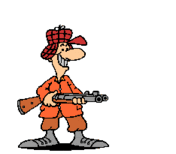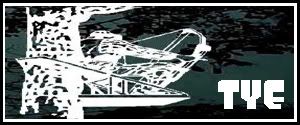Post by Woody Williams on Apr 3, 2006 8:23:14 GMT -5
Read all manufacture literature that comes with your crossbow and follow the instructions. Watch the video if they provide one.
Use a rope cocking aid or mechanical cocking device. You will get better accuracy and its a whole lot easier on your fingers.
Select a good target with adequate sized back stop. Crossbows are extremely fast and powerful. They can and will shoot through most targets. Stay focused of your surroundings and what is behind your target. Keep a watchful eye on children , pets , vehicles, buildings and the like.
Select and use the proper arrows that are recommended by the manufacture. To low of a weight will create a dry fire condition.
Do Not Dry Fire Your Crossbow.
It is recommended by the National Bowhunter Education Foundation that you do not attempt to cock your crossbow while in a elevated platform. It is way too easy to loose your balance and fall and there is no deer or turkey worth injury trying to get a second shot. Always wear a fall restraint device ...no matter what weapon your using.
Keep all thumbs and fingers below the rail while shooting. This is serious and probably one of the common injuries for crossbow users. A 150# or larger will feel no resistance as it tears through a finger or thumb.
Regularly go over your crossbow and check for loose screws , bolts and the like. Replace frayed strings and cables as necessary or by the manufactures recomendation . Keep your equipment in good working order.
Check to make sure limbs are "clear" of any tree limbs, trunk of the tree or obstacles before pulling trigger.
When stringing an Excalibur crossbow DO NOT be tempted to apply pressure on the stock for leverage.
After cocking bow, always set the safety (if bow does not set automatically).
Learn your shooting limits, and stay within them.
At final assembly, use clear fingernail polish (or blue Loc-tite) on all screws to prevent loosening from vibration and shock.
Always remove your arrow from your crossbow when climbing in and out of your tree stand.
Take along a field tipped arrow to uncock your crossbow.
It's always good to practice with field points but be very sure to practice with the bolt/broadhead combination you're going to hunt with. Even if the broadheads you choose are known to have the same POI as field points.
Spin test your hunting arrow/broadhead set-up to make sure your bolts/broadheads are straight.
Concentrate on your target and squeeze the trigger, don't pull/slap it as it will cause the bow to jerk. Follow through with your shots, try to watch your arrow’s flight until you hear the bolt hit the target.
FOLLOW THROUGH IS VERY IMPORTANT FOR ACCURACY..
" Aim small, miss small " or Pick a spot. Even if you do have a scope. Don’t aim at the entire animal , imagine a small target in the vital areas and smoothly squeeze the trigger.
Shot for an exit hole that will traverse both lungs if at all possible..
While hunting, periodically check to make sure your arrow is all the way back in your bow.
If it moves just a fraction of an inch it could cause a dry fire situation.
If hunting from a treestand, always cock the crossbow on the ground before climbing into stand.
Never raise or lower a cocked crossbow from a treestand with an arrow in it.
Watch how far you put your foot in the stirrup before cocking the crossbow, if it is not in deep enough (or a bit muddy ) and it slips off your foot WHAM sore mouth or missing teeth.
A sling on a crossbow is a benefit not just for carrying, but also to steady your bow while shooting. Wrap the sling around your forearm of teh arm that you use to hold the forearm of the crossbow and push out. This will help tremendously in steadying the crossbow for a shot.
Lightly tap your scope after you make an adjustment that you will have a more true setting when you shoot, as you will pre-set the reticule, and zero is less likely to change due to the jarring of a shot or transportation.
It is best to wax your string every 20-25 shots and to rub the wax in with a small piece of leather. It is also a benefit to keep your rail clear, scrape off excess wax with a credit card. A wax build up will create friction and have a minor effect on speed, a lot of guys swear by rail lube but the rail gets well lubricated by the string wax.
Again, follow the manufacturers recommendations on lubricating the rail.
Mark your serving with white paint on each side of the rail as close to the rail as possible.
If the crossbow is cocked crooked you can tell at a glance..
Use a rope cocking aid or mechanical cocking device. You will get better accuracy and its a whole lot easier on your fingers.
Select a good target with adequate sized back stop. Crossbows are extremely fast and powerful. They can and will shoot through most targets. Stay focused of your surroundings and what is behind your target. Keep a watchful eye on children , pets , vehicles, buildings and the like.
Select and use the proper arrows that are recommended by the manufacture. To low of a weight will create a dry fire condition.
Do Not Dry Fire Your Crossbow.
It is recommended by the National Bowhunter Education Foundation that you do not attempt to cock your crossbow while in a elevated platform. It is way too easy to loose your balance and fall and there is no deer or turkey worth injury trying to get a second shot. Always wear a fall restraint device ...no matter what weapon your using.
Keep all thumbs and fingers below the rail while shooting. This is serious and probably one of the common injuries for crossbow users. A 150# or larger will feel no resistance as it tears through a finger or thumb.
Regularly go over your crossbow and check for loose screws , bolts and the like. Replace frayed strings and cables as necessary or by the manufactures recomendation . Keep your equipment in good working order.
Check to make sure limbs are "clear" of any tree limbs, trunk of the tree or obstacles before pulling trigger.
When stringing an Excalibur crossbow DO NOT be tempted to apply pressure on the stock for leverage.
After cocking bow, always set the safety (if bow does not set automatically).
Learn your shooting limits, and stay within them.
At final assembly, use clear fingernail polish (or blue Loc-tite) on all screws to prevent loosening from vibration and shock.
Always remove your arrow from your crossbow when climbing in and out of your tree stand.
Take along a field tipped arrow to uncock your crossbow.
It's always good to practice with field points but be very sure to practice with the bolt/broadhead combination you're going to hunt with. Even if the broadheads you choose are known to have the same POI as field points.
Spin test your hunting arrow/broadhead set-up to make sure your bolts/broadheads are straight.
Concentrate on your target and squeeze the trigger, don't pull/slap it as it will cause the bow to jerk. Follow through with your shots, try to watch your arrow’s flight until you hear the bolt hit the target.
FOLLOW THROUGH IS VERY IMPORTANT FOR ACCURACY..
" Aim small, miss small " or Pick a spot. Even if you do have a scope. Don’t aim at the entire animal , imagine a small target in the vital areas and smoothly squeeze the trigger.
Shot for an exit hole that will traverse both lungs if at all possible..
While hunting, periodically check to make sure your arrow is all the way back in your bow.
If it moves just a fraction of an inch it could cause a dry fire situation.
If hunting from a treestand, always cock the crossbow on the ground before climbing into stand.
Never raise or lower a cocked crossbow from a treestand with an arrow in it.
Watch how far you put your foot in the stirrup before cocking the crossbow, if it is not in deep enough (or a bit muddy ) and it slips off your foot WHAM sore mouth or missing teeth.
A sling on a crossbow is a benefit not just for carrying, but also to steady your bow while shooting. Wrap the sling around your forearm of teh arm that you use to hold the forearm of the crossbow and push out. This will help tremendously in steadying the crossbow for a shot.
Lightly tap your scope after you make an adjustment that you will have a more true setting when you shoot, as you will pre-set the reticule, and zero is less likely to change due to the jarring of a shot or transportation.
It is best to wax your string every 20-25 shots and to rub the wax in with a small piece of leather. It is also a benefit to keep your rail clear, scrape off excess wax with a credit card. A wax build up will create friction and have a minor effect on speed, a lot of guys swear by rail lube but the rail gets well lubricated by the string wax.
Again, follow the manufacturers recommendations on lubricating the rail.
Mark your serving with white paint on each side of the rail as close to the rail as possible.
If the crossbow is cocked crooked you can tell at a glance..






 I should be safe
I should be safe 